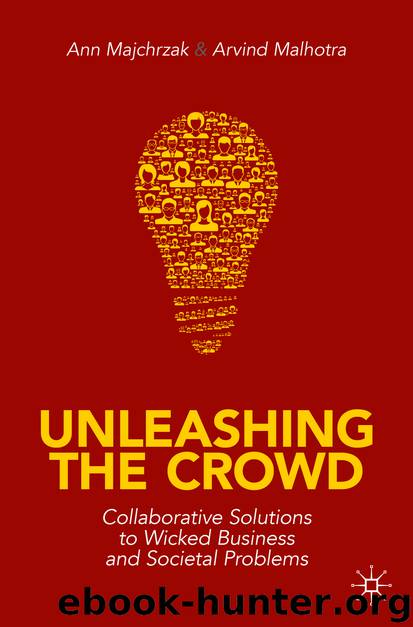Unleashing the Crowd by Ann Majchrzak & Arvind Malhotra

Author:Ann Majchrzak & Arvind Malhotra
Language: eng
Format: epub
ISBN: 9783030255572
Publisher: Springer International Publishing
5.3 What Are Creative Associations and How Can They Be Inspired?
Simply because knowledge is contributed by individuals in the collective does not mean it is understood and used for creativity.11 Not all knowledge sharing is generative; knowledge that is shared may not necessarily inspire or stimulate creative cognitive processes.12 Knowledge shared by the crowds, especially unmindcuffed crowds, can also become voluminous and evolve rapidly. The key to any trace (as we conceived traces and explained in Chap. 2) is that a trace represents the current moment’s state of knowledge, not the entire opus of all knowledge created by the crowd. As a participant enters the Innovation Crowdsourcing event website, there is a trace that is uniquely available to that participant at that point in time. Assuming this participant posts, the trace will be different for the next participant.
As mentioned in Chap. 4, traces can be very long (i.e., the entire chronological sequence of posts from the start of the crowdsourcing event to the end) or much shorter. Since the websites only show on the front page the five most recent posts, these become the minimum “freshest” trace for each participant. A participant may also choose to click on these recent posts or look at entire discussions for each thread lengthening the trace available to the participant. By looking only at the most recent five-post trace, however, participants are freed up from having to process all knowledge shared by the entire crowd. They can focus on the knowledge that immediately precedes that point in time when they are looking at the crowd’s posts. In that trace, then, there must be something posted that inspires creativity.
There are various obstacles that make understanding of others’ knowledge difficult, especially in collectives attempting to creatively solve wicked problems. One approach to overcome these difficulties that we discussed in Chap. 4 is adapted from the theory of knowledge misrepresentation gaps in cross-functional teams.13 The scholars who developed this theory argue that it is easier for members of the team to share and understand each other’s knowledge when the knowledge is distinguished by its purpose in a problem-solving process. They distinguish different types of knowledge by the value the knowledge type can bring to a problem-solving process: goals, assumptions, ideas, and ways to implement the ideas. We demonstrated in Chap. 4 that the crowdsourcing events are more likely to generate innovative ideas when a larger variety of these knowledge types are shared by the crowd. Note that ideas are only one of several knowledge types and not prioritized over the others.
How might knowledge fragments in traces inspire and stimulate creative cognition in others? There is substantial research on creative cognition that may suggest an answer lies in the dual subconscious creative association processes of generation and exploration.14 Each subconscious process works separately from the other—connected of course, but separate.
In the generation subconscious process, individuals use creative associations to link or search for existing knowledge from their own memory to identify solutions or components to solutions used in the past for analogically similar situations.
Download
This site does not store any files on its server. We only index and link to content provided by other sites. Please contact the content providers to delete copyright contents if any and email us, we'll remove relevant links or contents immediately.
Hit Refresh by Satya Nadella(9041)
The Compound Effect by Darren Hardy(8820)
Change Your Questions, Change Your Life by Marilee Adams(7640)
Nudge - Improving Decisions about Health, Wealth, and Happiness by Thaler Sunstein(7622)
The Black Swan by Nassim Nicholas Taleb(7016)
Deep Work by Cal Newport(6888)
Daring Greatly by Brene Brown(6451)
Rich Dad Poor Dad by Robert T. Kiyosaki(6414)
Principles: Life and Work by Ray Dalio(6227)
Playing to Win_ How Strategy Really Works by A.G. Lafley & Roger L. Martin(5938)
Man-made Catastrophes and Risk Information Concealment by Dmitry Chernov & Didier Sornette(5926)
Digital Minimalism by Cal Newport;(5669)
Big Magic: Creative Living Beyond Fear by Elizabeth Gilbert(5616)
The Myth of the Strong Leader by Archie Brown(5429)
The Slight Edge by Jeff Olson(5353)
Discipline Equals Freedom by Jocko Willink(5291)
The Motivation Myth by Jeff Haden(5158)
Stone's Rules by Roger Stone(5027)
The Laws of Human Nature by Robert Greene(5003)
